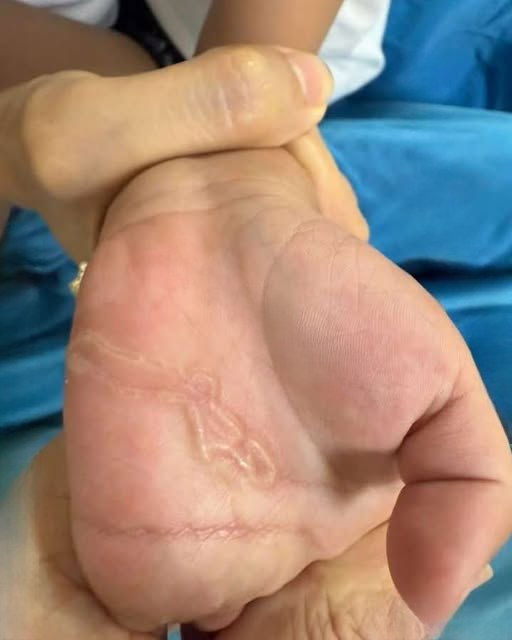Childhood is often filled with laughter, scraped knees, and playful adventures that leave behind stories to be told at family dinners. Most of the time, minor scratches and bruises are simply badges of exploration, healing within days without a second thought. But occasionally, something far less ordinary hides behind what looks like a small scratch.
This was exactly the case for a four-year-old boy from a quiet residential neighborhood. What began as an innocent scrape after an afternoon of playing in the sand quickly turned into a puzzling medical situation. His parents noticed mysterious, winding marks beneath the skin of his palm, leading them on an unexpected journey of medical visits, treatment, and education about an illness that many families rarely hear about.
The boy’s story not only highlights how quickly health concerns can escalate but also shines a light on a global condition that often goes unnoticed until it becomes severe.
From Simple Playtime to Unusual Symptoms
Like most young children, the boy loved playing outdoors, especially digging and building with sand near his home. After one afternoon of play, his parents noticed a faint scratch between his fingers. It seemed minor and unimportant—something every child experiences regularly.
However, just a few days later, they began to notice something different. Faint, twisting lines appeared under the skin of his hand. These marks looked like tiny winding trails, slowly expanding and shifting over time. The boy also began scratching at the area, complaining that his palm felt itchy.
What first appeared to be nothing more than a playful injury suddenly became alarming. The lines became more defined, and the irritation more persistent. Fearing that something was seriously wrong, his parents rushed him to the hospital.
The Medical Evaluation
At the hospital, doctors carefully examined the unusual marks. They ordered blood tests and ran other evaluations to understand what was causing the strange patterns.
The results revealed something surprising: the child had developed an infection caused by parasitic organisms that had likely entered his skin through the small scratch. These parasites, though rare in some parts of the world, are known to thrive in contaminated water or soil.
The good news was that the infection had been detected early. With timely medical care, the boy was able to begin treatment right away, which doctors explained would prevent serious complications. His case became not just a story of illness, but also a lesson in the importance of quick action and awareness.
Understanding the Hidden Culprit
The condition that affected the boy is known as schistosomiasis, sometimes referred to as a waterborne parasitic infection. It is caused by organisms that live in freshwater environments where sanitation is poor or water sources are contaminated.
While the name might sound unfamiliar to many, this illness remains a public health issue in several parts of the world. The life cycle of the parasite is complex and depends on both the environment and human activity:
Contaminated Water Sources – Eggs from the parasite can enter lakes, rivers, or ponds through waste.
Intermediate Host – Freshwater snails become infected and release larvae into the water.
Human Contact – When people play, bathe, or swim in such water, the larvae can penetrate the skin, especially if there are small cuts or abrasions.
Development in the Body – Once inside, the parasites move through the bloodstream, eventually settling in areas near organs such as the liver, intestines, or bladder.
Although adults are also at risk, children are especially vulnerable. They often play in natural water sources, may not recognize unsafe environments, and are more likely to have small scrapes that make infection easier.
Symptoms: From Early Warning Signs to Long-Term Effects
Health experts note that parasitic infections like schistosomiasis progress in stages.
Early symptoms may include:
Itchy skin or small rashes where the organism entered
Mild fever and body aches
Abdominal cramps or discomfort
Coughing or breathing difficulties in some cases
If untreated, long-term effects may include:
Digestive problems such as persistent pain or diarrhea
Enlargement of organs like the liver or spleen
Fatigue and weakness caused by anemia
Blood appearing in urine or stool due to tissue irritation
Because these symptoms can mimic other common illnesses, the infection often goes unnoticed for months or even years in regions where it is common.
Why Early Detection Saves Lives
The boy’s story demonstrates how vital early detection can be. His parents noticed unusual changes and sought medical help quickly, which allowed doctors to begin treatment before the infection caused long-term damage.
In many communities, however, infections are not identified until they reach an advanced stage. This delay makes treatment more challenging and can lead to permanent health problems. Regular check-ups, health education, and awareness are therefore essential.
How Families Can Protect Children
Doctors who treated the boy emphasized that prevention is always more effective than treatment. They offered several key recommendations:
Avoid unsafe water – Children should not play or swim in stagnant, dirty, or unknown water sources.
Ensure clean water use – Drinking, bathing, and cooking should only be done with treated or boiled water.
Encourage good hygiene – Washing hands and feet after outdoor play helps remove potential contaminants.
Promote sanitation – Communities benefit greatly from proper waste disposal systems.
Consider deworming programs – In high-risk areas, preventive medicine can lower infection rates significantly.
These steps, though simple, can drastically reduce the chances of exposure.
Schistosomiasis in a Global Context
Although the case might sound rare to some readers, schistosomiasis is far from uncommon worldwide. According to the World Health Organization (WHO):
Over 200 million people are affected globally each year.
The illness is most common in sub-Saharan Africa, parts of Asia, and South America.
Children represent a large percentage of cases due to frequent exposure.
Global health initiatives are making progress in combating this illness. Programs focus on sanitation improvements, large-scale medicine distribution, and health education campaigns. Countries such as China and Egypt have shown significant reductions in infection rates thanks to these efforts.
Why Children Are More Vulnerable
There are several reasons why children, like the boy in this case, are more at risk:
Playful exploration – Kids often play in water, sand, or mud without recognizing the dangers.
Small cuts and scrapes – Young children frequently get minor skin injuries that make entry points easier.
Developing immunity – Their immune systems are still growing, making infections potentially more harmful.
Limited awareness – Unlike adults, children do not understand why certain areas should be avoided.
This is why many health campaigns place a strong focus on schools and families with young children.
The Emotional Toll on Families
Beyond the physical illness, there is also the emotional impact. For parents, watching a child suddenly develop a strange and unfamiliar condition can be overwhelming. Feelings of fear, guilt, and uncertainty are common.
Health professionals stress that parents should not blame themselves. Parasites are invisible to the naked eye, and without awareness, prevention can be difficult. The best response is education and proactive action moving forward.
The Role of Communities and Governments
While individual families play a role in prevention, larger solutions require community and governmental involvement. Key measures include:
Building sanitation facilities and safe toilets
Expanding access to treated and safe drinking water
Running public education campaigns
Offering medical screenings and routine check-ups in high-risk regions
When communities invest in these efforts, infection rates drop quickly, proving that prevention works on a large scale.
A Story of Recovery and Hope
The young boy at the center of this story is now doing much better. With medical treatment, his condition is improving, and doctors are optimistic about his full recovery. His case is a reminder that while parasitic infections are serious, they are both treatable and preventable.
For his family, this experience became a powerful lesson in awareness. What started as an ordinary day of play ended up being a wake-up call about hidden health risks.
Practical Advice for Parents Everywhere
Health experts encourage parents to take proactive steps in protecting children:
Teach kids about safe play and the importance of avoiding unknown water sources.
Provide protective shoes when children play outdoors.
Watch for unusual skin marks, rashes, or itching.
Visit a doctor promptly if symptoms appear.
Stay informed about local health warnings or water safety advisories.
These simple steps can make the difference between a small concern and a major health challenge.
Conclusion: Knowledge as the Best Defense
The story of this four-year-old boy is more than a medical case—it is a valuable reminder for families and communities around the world. Childhood play should be full of fun and discovery, not hidden risks. Yet, in certain environments, unseen dangers can exist.
Schistosomiasis, though preventable, continues to affect millions globally. The key to reducing its impact lies in awareness, education, sanitation, and early medical attention.
For the boy and his family, quick action brought relief and recovery. For the rest of us, his story encourages vigilance and reminds us that knowledge truly is the strongest shield against hidden health threats.

